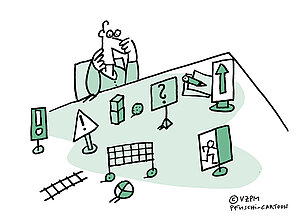Project design
Definition
Design describes how the demands, wishes and influences of the organisation(s) are interpreted and weighed by the individual and translated into a high-level design of the project to ensure the highest probability of success. Derived from this outer context, design drafts a ‘charcol sketch’ - a blueprint or overall architecture of how the project should be set up, laid out and managed. This considers resources, funds, stakeholders’ objectives, benefits and organisational change, risks and opportunities, governance, delivery, priorities and urgency. Because all outer factors and success criteria (and/or the perceived relevance of these) often change over time, this design needs to be evaluated periodically and, if necessary, adjusted.
Purpose
The purpose of this competence element is to enable the individual to successfully integrate all contextual and social aspects and derive the most advantageous approach for a project to ensure buy-in and success.
Description
Design addresses the development, implementation and maintenance of an approach that best serves the organisational objectives and takes into account all formal and informal factors that help or hinder the corporate goals and the success or failure of the specific project. Design includes taking into account the intent, governance, structures and processes, relevant standards and regulations, cultural aspects, and personal and group interests in the organisation (or organisations) and the wider society. In selecting the choice for the approach, lessons learned from other projects within the organisation, the industry or from outside and the specifics of this project, also play an important role.
Design addresses a broad range of aspects, including decision-making, reporting and resources, as well as meeting standards and regulations and complying with cultural norms and values (within the organisation and the wider society). Aspects such as perceived benefits, motivation, team and stakeholder communication, etc have also to be taken into account. Defining these objectives, factors and criteria distinctly and clearly is a major requirement from the outset and during the execution of the project. This activity results in a thoroughly situational high-level sketch that will later be translated into specific actions that should lead to success for the project.
The chosen approach also includes the management and control philosophy. The architecture reflects rhythm, balance and commitment and provides guidance to the project tasks and their place in the project.
The selection of the approach and the design activities have to be performed before jumping into planning, organising and executing the project. Furthermore, during the project’s lifecycle this chosen approach should be regularly ‘re-thought’ and challenged as circumstances change both from within the project and from the larger context.
Key competence indicators
Acknowledge, prioritise and review success criteria
Success criteria are measures that stakeholders use to rate and judge the success of the project. These criteria can be both formal and informal. Formal criteria address the stated objectives of the project. To achieve these goals and objectives within the agreed constraints (e.g. strategic goals, tactical and operational objectives) is one – but just one – part of project success. Informal criteria by which interested parties evaluate the outcome are also important. These factors may include the true reasons why a project is started, supported, thwarted or ended. Success criteria also address the interaction with the larger context – the personal or group interests that are influenced by the project or its result, depending on how a project supports or conflicts with other projects and programmes, activities, goals, resources, etc.
The individual collects, acknowledges, prioritises and completes both formal and informal success criteria for the project. Not only the formal criteria, but also the informal ones, need to be taken seriously by the individual, as they will significantly influence the willingness of interested parties to support and cooperate with the project and so directly influence its success. The success criteria play a crucial role in defining the approach. For instance, if the main criterion is the quality of the end product, quality processes, quality reviews and assurance and quality consideration will play an important role in the chosen approach. This approach would differ substantially from a project with the focus on time (speed of delivery) or budget. Success factors are elements that individuals can incorporate into their project to increase the likelihood of meeting the success criteria and achieving a successful outcome. These factors may come from very different sources and take different shapes. They vary from using (or avoiding) specific tools, methods or techniques, selecting specific resources, organisation setup, stages, reporting and communication means and styles, quality methods, etc. During the course of every project the relative importance of success factors and criteria may change, due to contextual or social aspects and the dynamics of the project itself. Therefore the individual periodically checks and assesses the actuality and relative importance of the success criteria and – when necessary – makes due changes in the approach in order to attain success. These changes may even include advising the organisation to prematurely end the project.
Measures
- Identifies, classifies, evaluates and prioritises influences from each of the five perspective aspects relevant for success
- Recognises and assesses both formal and informal influencing elements
- Evaluates and prioritises success criteria from each of the five contextual aspects
- Acknowledges and assesses both formal and informal success criteria
- Acknowledges and uses relevant success factors
- Performs periodic re-assessments of the relevance of success criteria
- Performs periodic re-assessments of the relevance of success factors
Review, apply and exchange lessons learned from and with other projects
At the start of the project, the individual gathers lessons learned from previous projects (both from his or her own organisation(s) and from the wider community, including research and benchmarks) and applies relevant lessons in the present project. Periodically and at the end of the project, the individual (with the team and relevant stakeholders) evaluates the approach and gathers lessons learned from the current project. They shall be shared within the organisation. The individual knows and uses the different methods and tools for distributing lessons learned in the organisation (e.g. strategic project office, knowledge base, internal social network, etc).
Measures
- Acknowledges and gathers lessons learned from previous projects
- Applies relevant lessons learned
- Acknowledges and uses research and benchmarking methods for improving the performance of the project
- Identifies and shares lessons learned from the project with the organisation
Determine complexity and its consequences for the approach
To properly select an appropriate approach, the individual has to take into account the specific complexity of the project – the complexity of the agreed outcomes and/or of the project processes required. The complexity may have many causes and sources. It may be that the outcomes or necessary internal processes of the project are innovative, technically complex and/or strongly intertwined. It may be that the project involves many teams, people, suppliers, dependencies, etc. It may be that the context of the project is complex, for instance many stakeholders with varying interests, many interfaces with other processes, projects, programmes, etc. Timelines may be short, budgets limited, outcomes crucial for the organisation, etc. All these internal and external factors have to be taken into account by the individual because they play an important role in defining the optimal approach for the project.
Measures
- Identifies the level of complexity of the project by applying appropriate methods
- Acknowledges complexity-enhancing aspects
- Identifies and defines the impact on complexity of specific processes, constraints or outcomes
- Identifies and assesses the impact on complexity of specific external and internal parameters
- Assesses and applies complexity-diminishing measures
Select and review the overall project management approach
At the very beginning of the project, the individual chooses an approach that has the highest probability of success, given the constraints of contextual influences and demands, complexity of the project, lessons learned, known success criteria and available success factors. The approach may contain a vision (main principles) and an architecture for the project to reach success. This approach may include a high-level definition (or modification) of scope, quality aspects, organisation, communication, documentation, planning and stakeholder approach, choice of resources, risk tolerance, management and performance criteria, etc. The individual reviews the approach periodically, because many of the contextual and social influences may change over the lifecycle of the project.
Measures
- Assesses and appraises various possible approaches
- Selects an approach for the project that has the highest chance of leading to success
- Explains and defends the chosen approach and its relation to the success of the project
- Explains the main effects of the chosen approach on the organisation of the project
- Explains the main effects of the chosen approach on the parent organisation
- Periodically re-evaluates the chosen approach based on contextual and internal developments
- Makes necessary changes to the approach and explains why these were made
Design the project execution architecture
Based on the selected approach, the individual draws a high-level ‘charcoal sketch’, a blueprint or even architecture for the project. This high-level plan will be detailed later via formalised plans, but the basic design only considers the essential choices (such as make or buy, waterfall or iterative, internal resources or external, what tools and methods to use, etc) and the consequences of each choice for success. These choices made by the individual also include the best way to lead the project. Project management success is an essential part of, and prerequisite for, project success. In some circumstances, this may mean choosing a strong profile as leader, or, given other criteria, act as ‘first among equals’ towards the team or the stakeholders. Often this choice will vary with circumstances and environments and/or the phase the project has reached. In the course of the project the individual periodically evaluates (aspects of) the design, taking into consideration the development and progress of the project, changing contextual influences and demands, known success criteria and available success factors. This often leads to minor or major changes in the chosen execution architecture.
Measures
- Establishes the project execution architecture with outcomes
- Defines the business rules and control philosophy
- Monitors the project against the architecture components
- Updates the architecture based on changes


